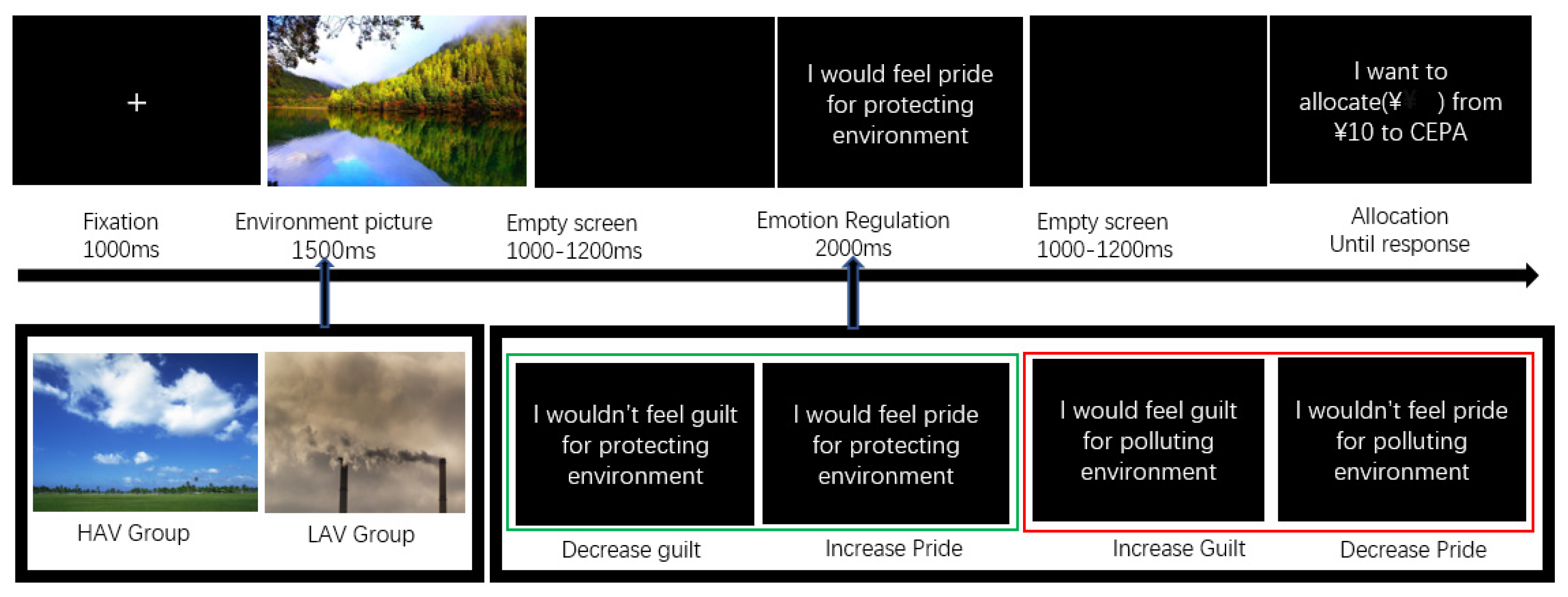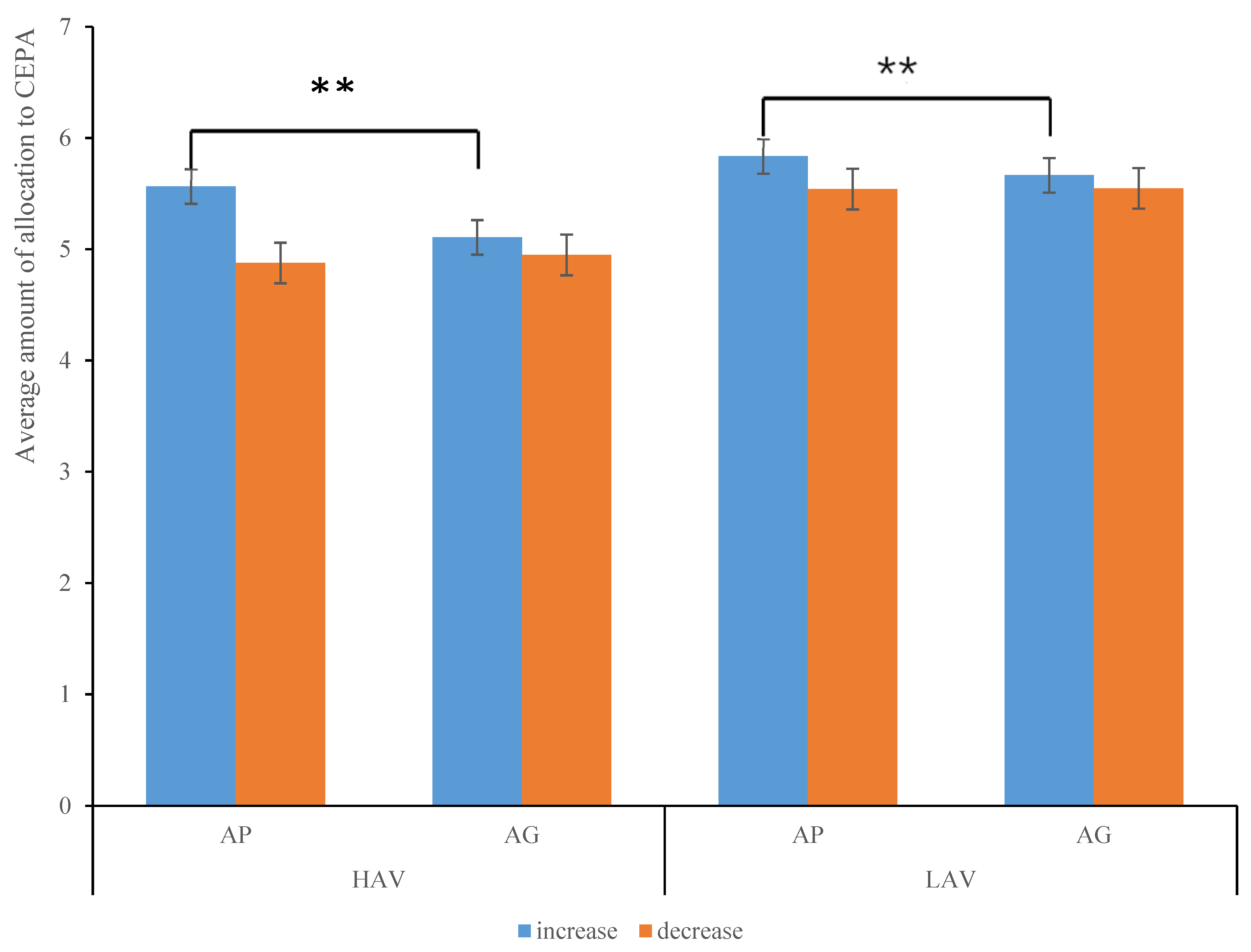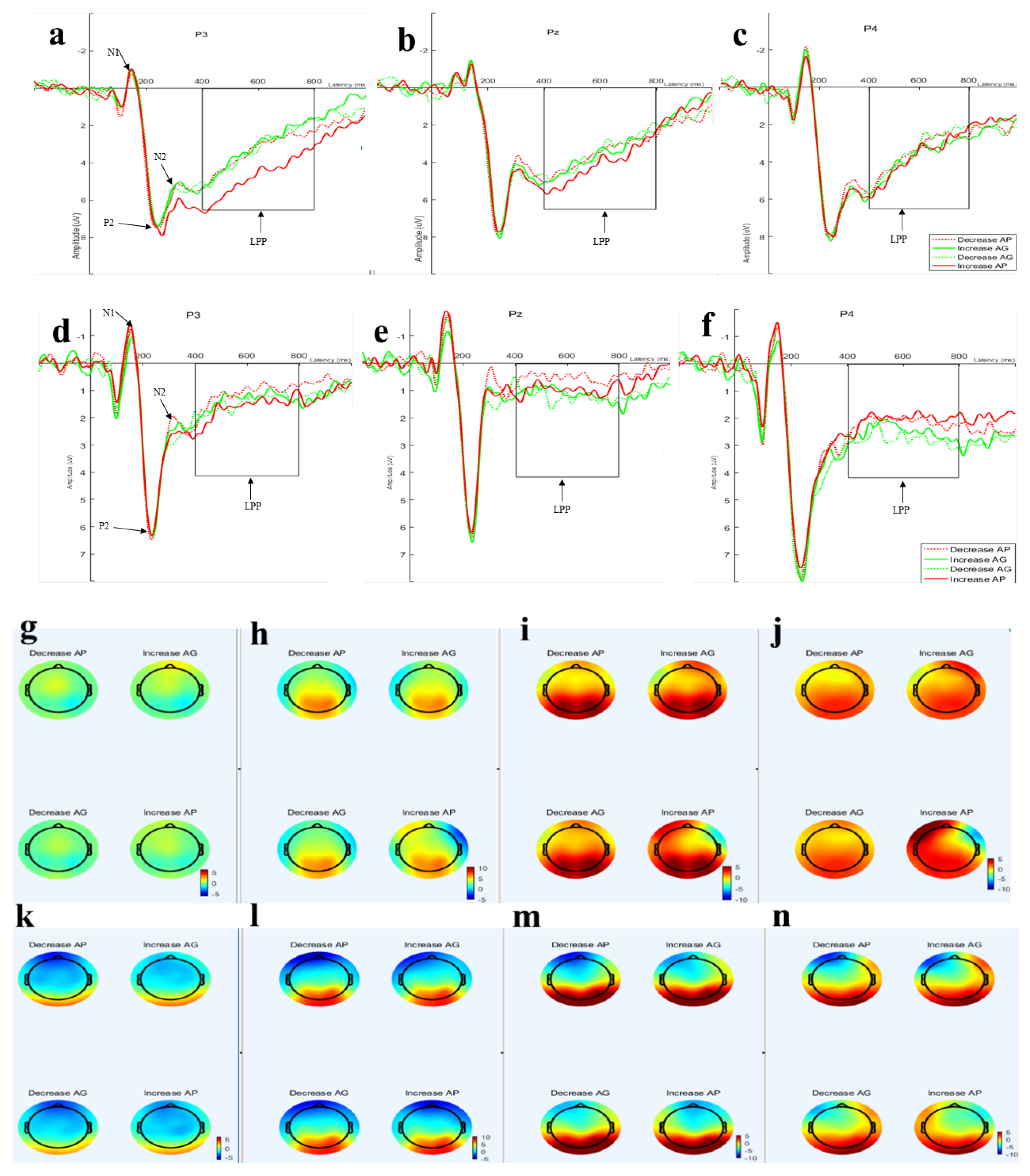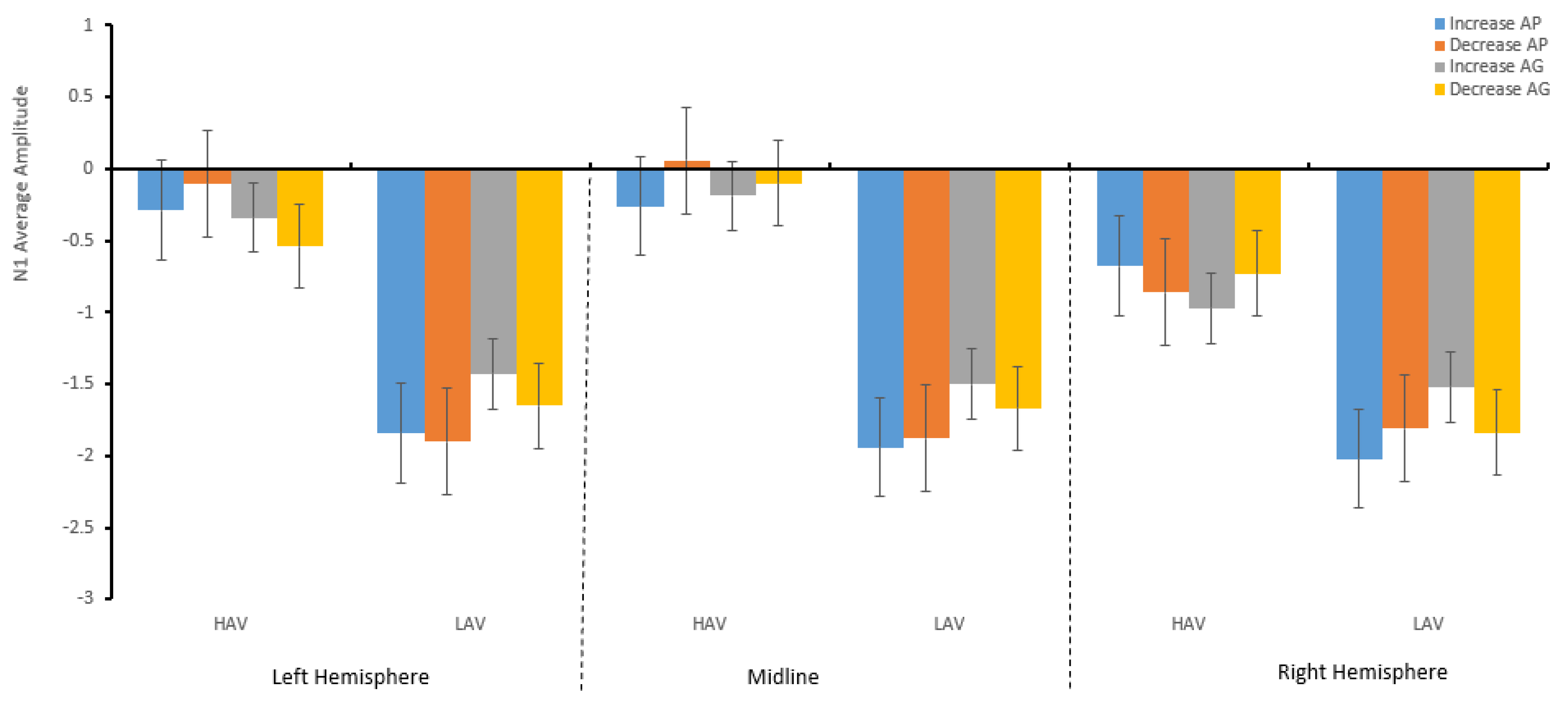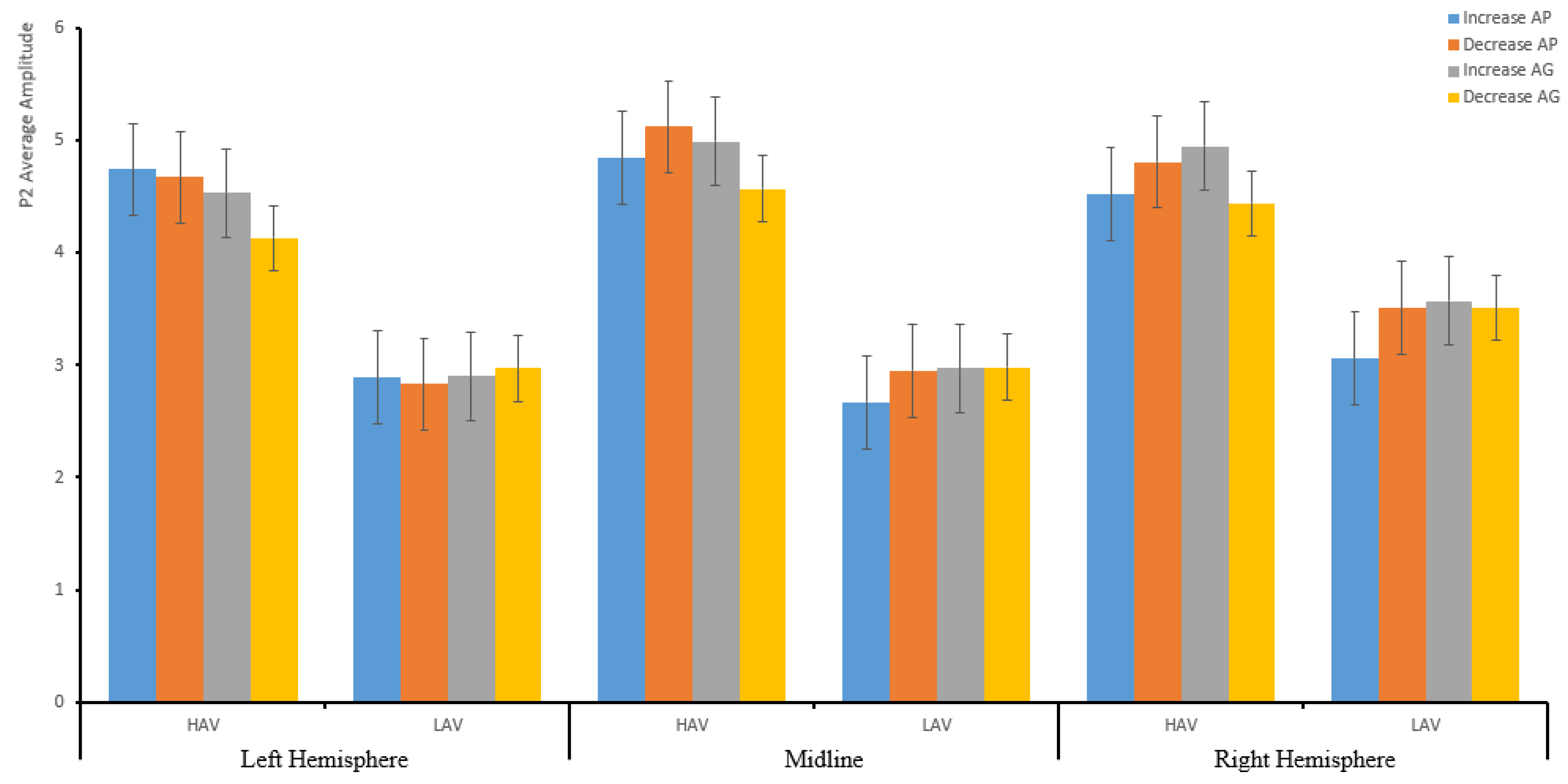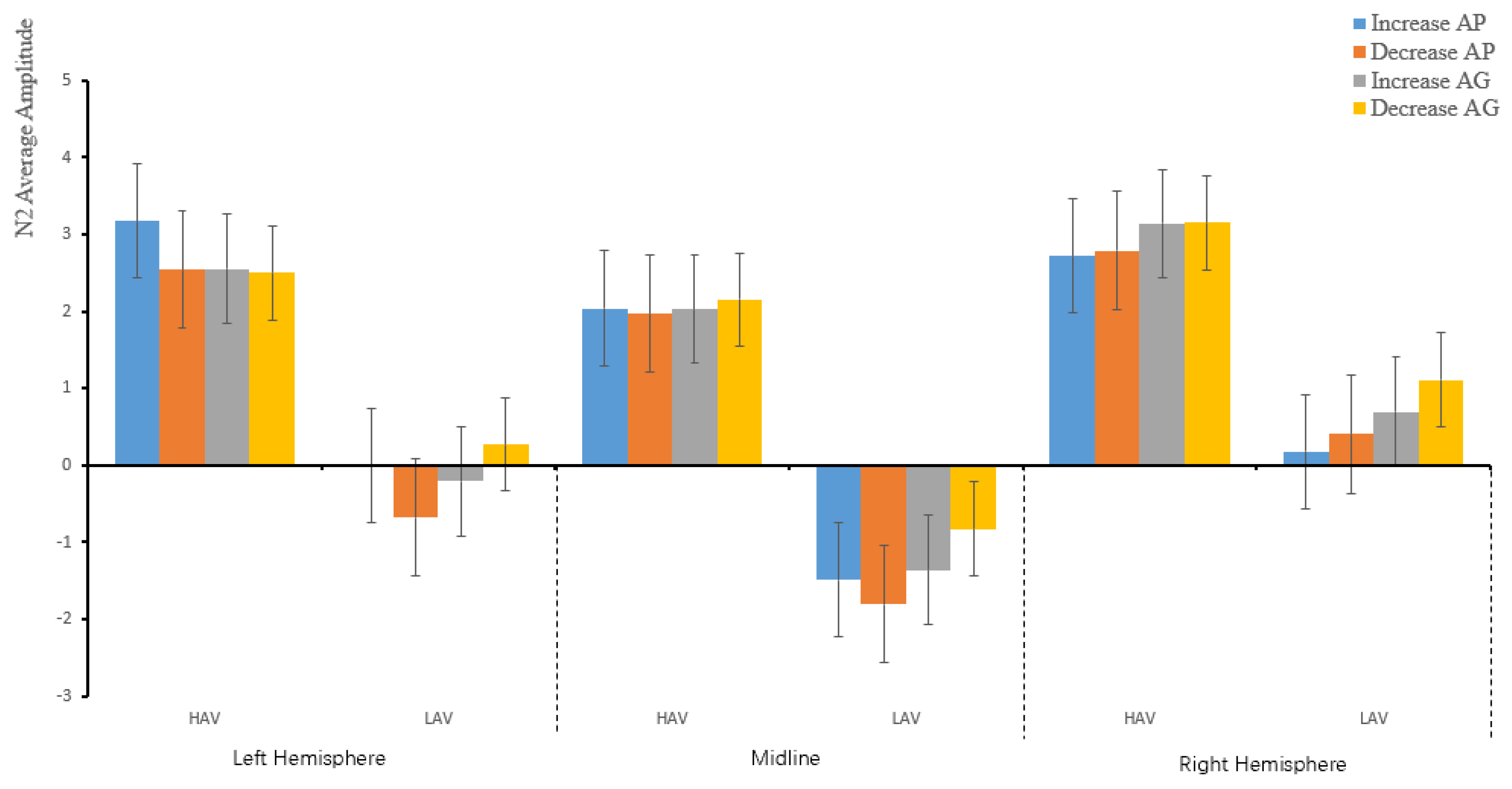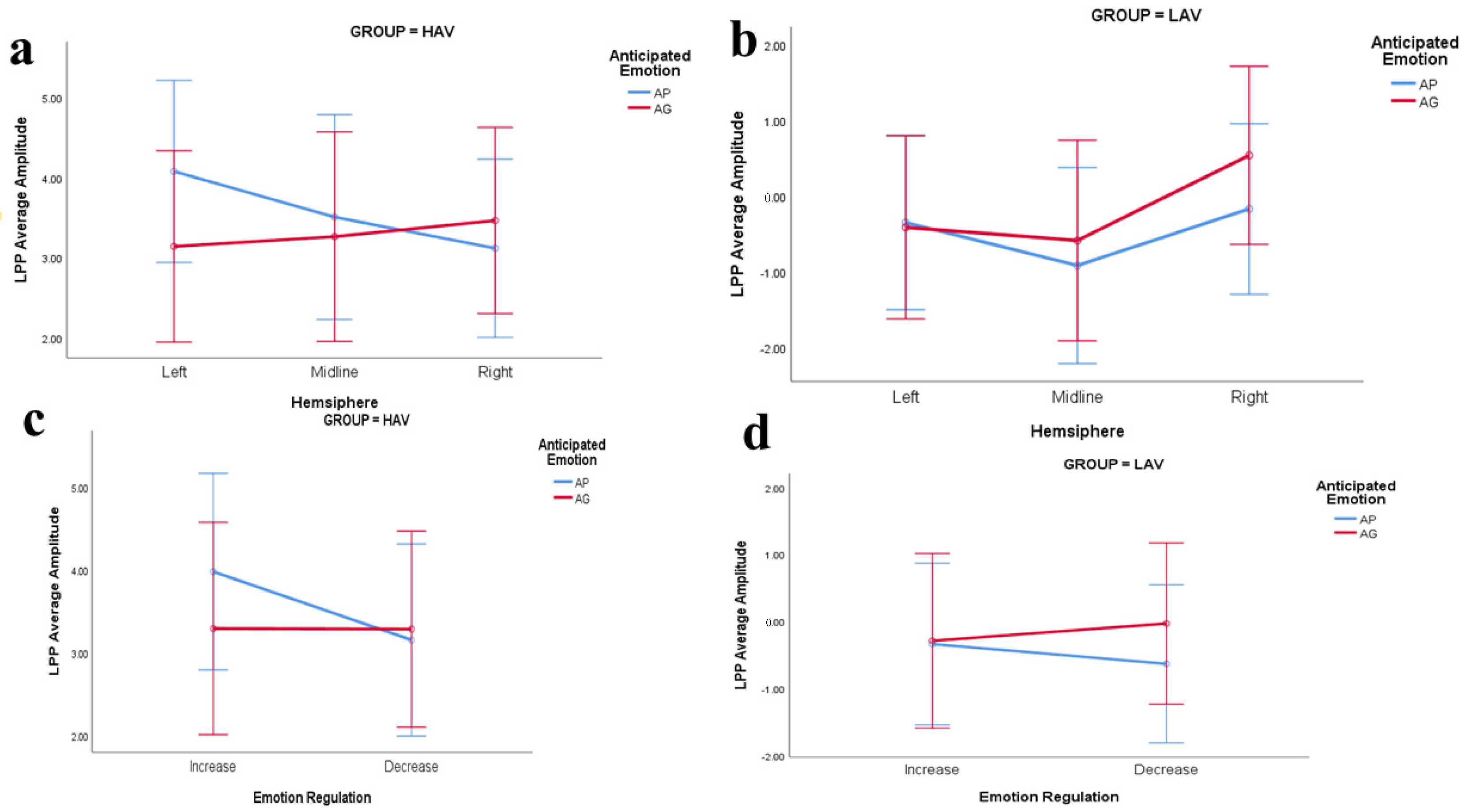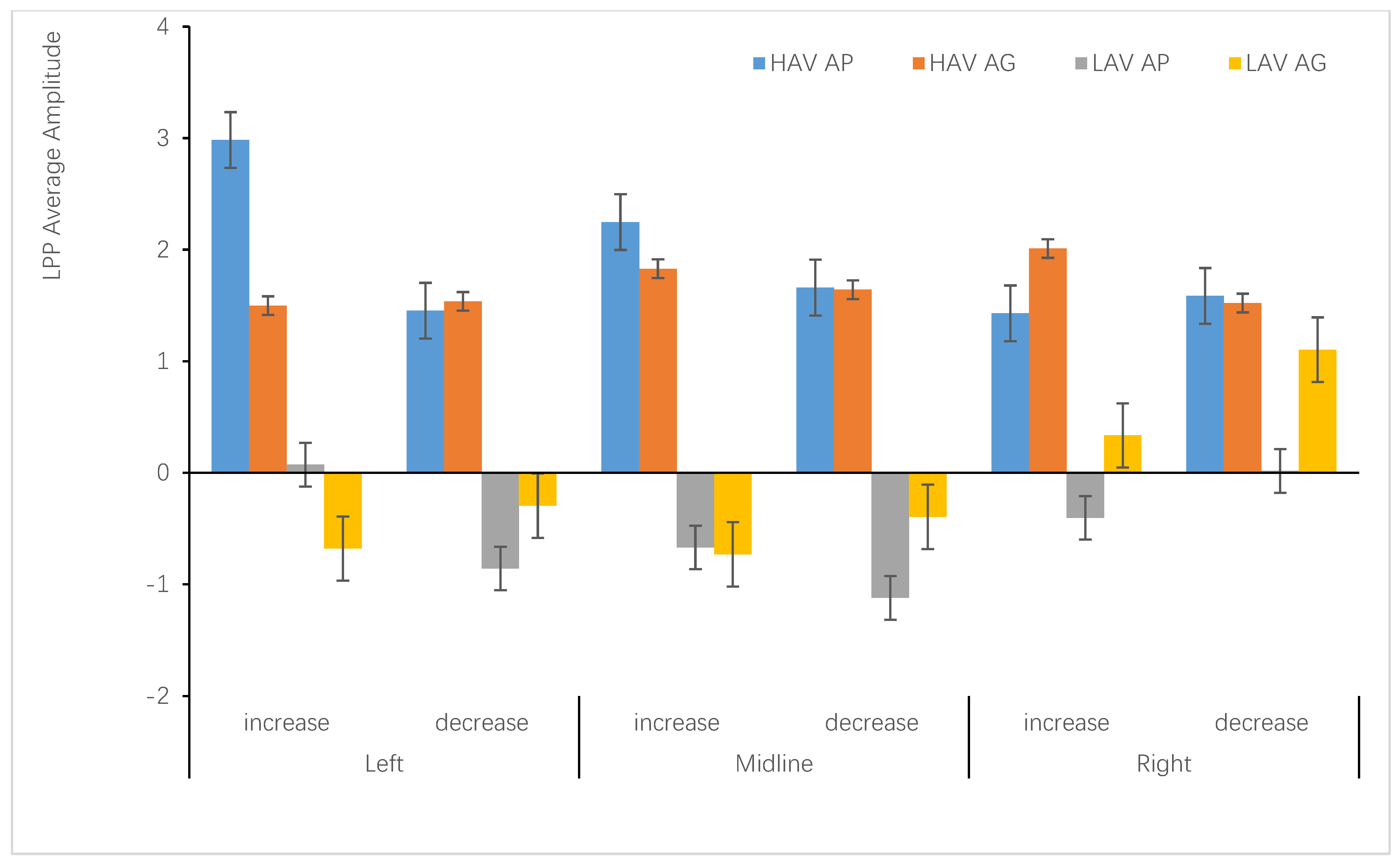1. Introduction
People from diverse backgrounds may often experience the same event differently, which results in divergent behaviors [
1,
2,
3,
4,
5,
6]. In other words, multiple perspectives can result in a diverse understanding, and thus, varied behaviors. In many studies, this phenomenon is described as the framing effect [
7,
8,
9,
10]. At present, environmental protection is one of the most important concerns for human existence [
11]. The motivations for it are specifically based on two opposing aspects. First, regarding a high-aesthetic-value (HAV) environment, to ensure that the environment continues to be suitable for human survival, actions toward its protection should be prioritized. Second, the environment needs to be protected well because human beings cannot survive in polluted and destroyed environments. Therefore, it is important to repair the living environment. The final behavior resulting from these two antecedents is an individual’s pro-environmental behavior.
Several studies have been conducted on pro-environmental behavior. It refers to behavior that induces little to no harm or that benefits the environment [
12]. It encompasses every aspect of life, and everyone can engage in pro-environmental behaviors as best as they can [
13,
14,
15,
16,
17,
18].
According to the perception-emotion-behavior model, the reasons for human engagement in pro-environmental behaviors may be motivated by external environmental cues or by internal motivations. Furthermore, the physical environment wherein humans engage in pro-environmental behavior is the immediate external factor that plays an important role in their behavior [
17]. Along with the aesthetic impressions people receive from their environment [
19], a wide range of psychophysiological responses are affected by it [
20], including memory [
21], stress [
22], attention [
23], and well-being [
24]. Studies have suggested that participants with a stronger intention of engaging in moral behavior in an environment were associated with having a HAV, whereas a decreased intention was associated with a low aesthetic value (LAV). Thus, an environment with a LAV is related to immoral behavior [
25]. Pro-environmental behavior is considered altruistic and moral behavior. Studies have found that pictures of a positive emotional environment can promote positive emotions and are associated with a reduced intention to take action to protect the environment. In contrast, pictures of negative emotional environments augmented negative emotions and increased the willingness to pay attention to and protect the environment [
26].
The perception-emotion-behavior response is the core of human altruism, which frequently occurs in real life [
27]. Scholars have indicated that individuals experience positive or negative emotions in their daily life and can anticipate their emotion from engaging in a particular behavior [
11]. Anticipated emotions are based on future outcomes [
11]. Hence, the emotions people experience while in the physical environment will be similar to the imagined future environment. The emotions that they have not experienced will significantly impact the individual’s cognitive processes [
28], behaviors [
29], and decision-making processes [
30], the same as the experienced emotion. Anticipated feelings, such as pride and guilt, are often regarded as self-conscious emotions. The self-conscious emotion is a special type of emotion that involves the ego, and it is particularly relevant to comprehending environmentally responsible decision-making processes or behaviors consistent with the Norms Activation Model (NAM) [
31]. Furthermore, these feelings have a distinct role in an individual’s decision-making processes for pro-social and -environmental behavior [
11,
28,
32]. Self-conscious emotions have self-regulatory functions. Onwezen and colleagues confirmed that anticipated emotions mediate the effects of personal norms on behavior and affected behavior through behavioral intentions [
11]. Moreover, anticipated emotions are often overestimated such that the emotions one anticipates are more extreme than the ones experienced during the event [
30]. Individuals strive to experience positive emotions and avoid negative ones. Research findings imply that there was an increased sense of environmental moral responsibility among individuals who felt guilty about past or failed actions [
33]. Anticipated emotions are particularly relevant in understanding individual decision-making [
34,
35,
36,
37,
38,
39].
Scholars have described the anticipated emotional response based on the prospect of success and failure as pre-evaluation, also known as pre-thinking or anticipated thinking [
40]. Emotions emerging from these personal or social standards promote prosocial or altruistic behavior [
41] and have been examined for their influence on pro-environmental behavior [
41]. However, factor analysis revealed inconsistencies in individual environmental behavior [
12]. For example, people might exhibit environmentally friendly behaviors in waste recycling but environmental burdens regarding transportation [
42]. Moreover, research has suggested that different types of information could either promote or dampen pro-environmental behavior and subsequent spillover effects [
43]. Another finding regarding the strong support for environmental protection was contrasted by low actual pro-environmental behavior [
44].
Regarding inconsistencies between behavioral decisions and situations, the framing effect is worth mentioning. One of the most robust and important findings in the psychology of decision-making is the dramatic influence of framing [
45,
46]. At times, framing is simply choosing the correct way of labeling an environmental policy that can influence choice. However, in a much broader sense, it can have implications for the way people view environmental issues and the extent to which they feel morally responsible and motivated to engage in pro-environmental behavior [
47].
Research on the effects of pride and guilt on message framing found that pride and guilt have different behavioral effects when combined with positive and negative framing, respectively [
48,
49,
50,
51]. The event-related potential (ERP) is a neuroscience technology with a high temporal resolution property, which can be used to investigate the temporal dynamics of decision-making information processing [
52,
53,
54]. ERP research on message framing regarding green purchase established that the influence of positive framing was higher on participants’ intention, which was supported by different ERP components, N1\P2\late positive potential (LPP) in the three stages of time processing. The effects of attentional resources, guilt, and pride impact purchase intention when processing positive and negative message framing [
55]. Specifically, the study found that increased pride and decreased guilt through positive framing can increase purchase intention for green products, whereas increased guilt and decreased pride can reduce it through negative framing. This finding differs from previous views that positive emotions reduce the intention to protect the environment, and negative emotions increase the willingness to pay attention and protect the environment [
26]. Subtle positive emotional environments that are not task-related could significantly impact decision-making.
Evidence revealed that environmental pictures of positive emotions presented before an individual’s decision were sufficient to neutralize the framing effect by reducing the aversion aspect of affirmative loss [
46]. While the participants regulated their emotions, a consistent trend was observed for the negative conditions wherein pictures caused increased regulation to elicit the most positive LPP amplitude, while maintaining the negative emotion condition elicited a more minimal LPP amplitude [
56]. The study results showed a significant effect of the regulation condition for a time window of 350 to 750 ms for the LPP amplitude occurring at 350 to 3000 ms [
56]. Furthermore, research demonstrated that the LPP generation, which Ochsner and Gross (2007) referred to as the perceptual appraisal system, is attributed to the parietal, occipital, and temporal cortices [
57]. Moreover, the decreasing emotions may incorporate and exacerbate memory interpretations associated with the LPP modulations during decreased instructions because its magnitude reflects activity [
57]. To support changes in emotional experience, studies recommend that alternative stimulus representations be generated in the perceptual appraisal system during emotion regulation [
58].
Two hypotheses were tested in this study: First, there is a difference between the environmental behavior of individuals in HAV and LAV environments, with the LAV environment expected to present more pro-environmental behavior. Second, in the process of increasing and decreasing anticipated emotions through environmental framing, neural processes are associated with individuals’ environmental behaviors, and the ERP components are changed by different tendencies under the circumstance of the HAV and LAV. We designed a 2 (environmental framing: negative vs. positive) × 2 (anticipated emotion: pride vs. guilt) × 2 (group: HAV vs. LAV) mixed experimental design to explore how environmental aesthetic values and anticipated emotions influence pro-environmental behavior through environmental framing. In this study, pro-environmental behavior refers to the specific amount that participants allocate to environmental organizations during the course of the experiment in a monetary allocation task related to their own reward for participating in the experiment.
4. Discussion
Our study explored the effects of anticipated emotion regulation and aesthetic value environment on pro-environmental behavior and its underlying neural mechanisms. The behavioral results, which found that people’s pro-environmental behaviors can be regulated by regulating anticipated emotions, validate the effect of self-conscious emotions on pro-environmental behaviors [
11,
48,
60]. Importantly, they revealed that people in the HAV or LAV environment could regulate anticipated emotions by the environmental message framing. When they regulated self-conscious emotions, such as anticipated pride and guilt, they would regulate individuals’ pro-environmental behaviors.
Specifically, the behavior results are consistent with those of previous studies on pro-environmental intention, which found that increased pride and decreased guilt by positive framing could increase purchase intention for green products, whereas increased guilt and decreased pride can reduce it through negative framing [
55]. The results of pro-environmental behavior verify that people’s pro-environmental behavior could be influenced by the regulation of anticipated emotions from the perspective of individual-specific pro-environmental behaviors, and they expand the research from pro-environmental intention to behavior.
The findings also extend research on emotion regulation. Scholars have reported that self-conscious emotions have a self-regulating function and that emotion regulation would be applied to the emotions being experienced [
25,
56] and to the regulation of anticipated emotions, and its effectiveness can be reflected in participants’ changes in specific behavioral tendencies and differences in ERP components. Our research confirms that anticipated emotions can influence people’s decision-making [
30].
In contrast to previous studies, these findings revealed that the internal factors of anticipated emotion influences behavior by activating temporal processing in different brain regions through ERP measures. It suggests that the aesthetic value environment can influence emotion regulation by increasing and decreasing the amplitude of the central or posterior lateralized area from different hemispheres by environmental message framing. This internal processing was manifested as a change in pro-environmental behavior in explicit behavior. It was consistent with the previous study of changes in LPP amplitudes in emotion regulation of the LPP [
61]. The results expand the specific time course and regularity of the lateralized processing of anticipated emotion regulation; that is, the largest average amplitude of increasing anticipated pride was located in the left posterior brain area, which had the same average amplitude when participants received the message of decreasing anticipated guilt. It suggests that the aesthetic value of environmental cues perceived by people could affect future anticipated emotional processing, which manifests mainly from the differences in each component of ERP processing located in the central and posterior brain regions from 140 ms to 800 ms. Specifically, it was embedded in the biased processing of brain regions. The experimental results showed that increasing and decreasing anticipated emotions will affect the change in excitation amplitude. Most importantly, it demonstrates that people’s perceptions of the aesthetic value of the external physical environment can have an intrinsic influence on anticipated emotional experiences, as manifested in explicit behaviors.
The results also indicated that the aesthetic value of the physical environment situation affects people’s pro-environmental behavior. However, the difference in the pro-environmental behavior between the HAV and LAV environments was not significant. The findings were not consistent with those of previous studies. The reason could be the role of emotion regulation, as we have conducted emotion regulation in HAV and LAV environments and have found changes in pro-environmental behavior in the emotion regulation process. The emotion regulation interacted with the perceptions of the HAV and LAV environments, which together regulated an individual’s pro-environmental behavior [
55].
5. Conclusions
This study examined the effects of increasing and decreasing anticipated emotions through environmental framing to anticipate the future impact on individuals’ participation in pro-environmental behaviors across the varying contexts of HAV and LAV. The behavioral results verified the hypothesis that increased anticipated emotions among individuals can increase their pro-environmental behavior and decrease anticipated emotions, thus reducing individuals’ pro-environmental behaviors. These behavioral results reaffirm the effects of anticipated guilt and pride on pro-environmental behaviors.
The results show that in the HAV situation, the processing of anticipated pride and guilt is significantly different in the left brain area, while in the low-aesthetic-value situation, the participants’ processing of anticipated pride and guilt is significantly different in the right brain area. Moreover, the difference between increasing pride and guilt in HAV situations is significant, while in LAV situations, there is a significant difference between reduced anticipated pride and guilt. From this result, we draw the following conclusions: individuals have significant differences in the anticipated emotion regulation processing in HAV and LAV situations, and their internal processing mechanisms are different.
These findings have practical significance in promoting environmental protection activities in daily life. Thus, corresponding environmental pictures can be set across different life situations and align with the appropriate environmental framing texts to ensure the improved promotion of pro-environmental behaviors in peoples’ daily lives as practical operations are feasible and easy to implement.
This study considered only the interaction effects of the HAV and LAV environments and emotion regulation on pro-environmental behavior, and did not explore the influence of the two variables of aesthetic value environment and emotion regulation on pro-environmental behavior, respectively. Future studies should explore the changing footprint of pro-environmental behavior from the perspectives of aesthetic value environment and emotion regulation, and how these variables affect pro-environmental behavior.
